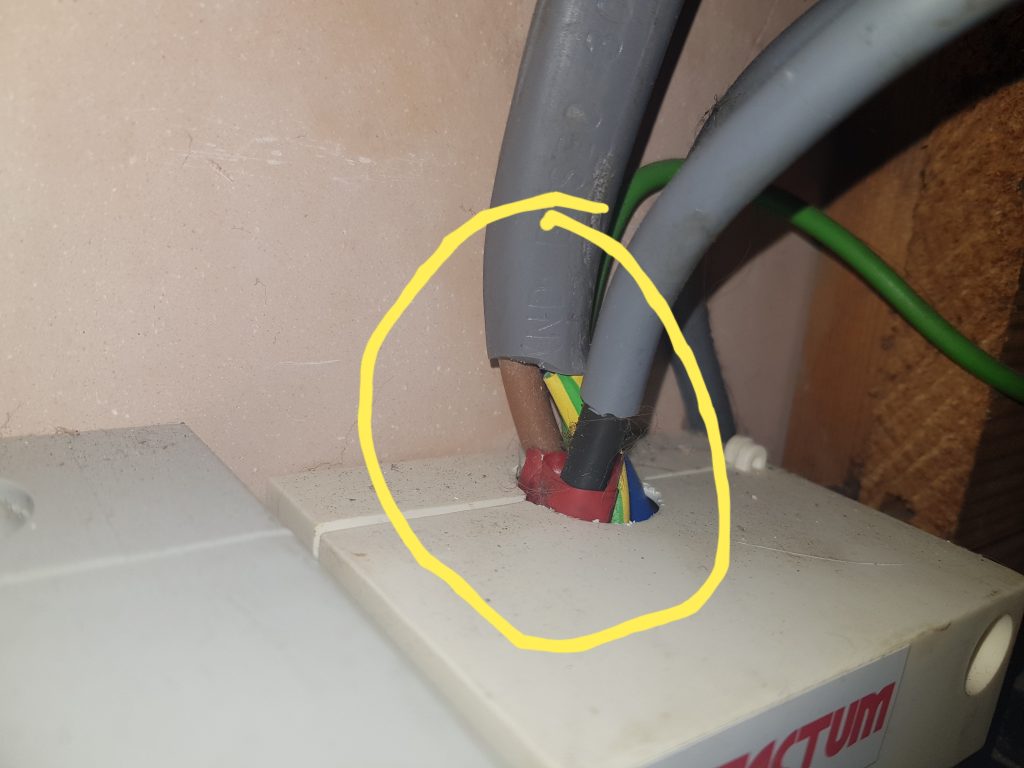Unsheathed Basic Insulation Outside Of Enclosure
If you’ve recently had a landlord/homebuyer report completed on a property and received a fault for “Unsheathed Basic Insulation“, you may be a little confused as to what this all means.
Sadly the terminology used within electrical reports may as well be in a foreign language (unless of course you are an electrician!). Many electricians also do not take the time to explain or provide pictures of the fault in order that you may understand further.
So lets take a look at what “Unsheathed Basic Insulation” is and why this is a problem:

Cable & Insulation
Without boring you to death with science, we need to quickly look at what makes up a cable so you can understand this type of fault.
A domestic power cable is mainly of a type called “Twin & Earth”. This is a “slang” term for BS6004 cable and comes from the fact that the cable has two equal sized conductors (Live & Neutral) and a separate “earth” conductor also.
The 2 main conductors are copper wire covered in “basic insulation” which is the first layer of insulation. In the case of domestic cables, this used to be coloured Red & Black (Live & Neutral respectively), however since 2004 are now coloured Brown & Blue (again, Live & Neutral respectively).
The “basic insulation” is then covered over with another layer of insulation. This layer is known as the sheath and on the cable in question is normally grey.
So What Is The Problem Exactly?
In order that a cable may be connected, for example into a socket, the insulation needs removing. First the sheath is stripped back to reveal the separate conductors within (and the basic insulation protecting them).
These are then spread to the correct terminals in the accessory. Once this is done a small amount of the basic insulation is removed to expose the inner copper core. This is then connected to the terminals.
All sounds OK so far right?
Well the wiring regulations require that no outer sheath of the cable is stripped back outside of the enclosure to which it is connected. This means that no basic insulation should ever be visible outside of the enclosure.
If the inner “basic insulation” is unsheathed outside of an enclosure, this greatly increases the risk of damage occurring to this. This is the only defence against dangerous live cores within the cable.
Knocks, bangs, movement, rubbing of the cable or excessive bending (which can cause splitting) are all possible ways in which the basic insulation can be damaged.
Expect this to be classed as C2 – POTENTIALLY DANGEROUS if the basic insulation is unsheathed anywhere where it may be accessible to touch. A prime example of this would be in the meter cupboard, an area easily accessible by the end user.
This fault may attract a C3 – IMPROVEMENT RECOMMENDED code if the cable is in an area not accessible to touch.
Regardless of whether accessible to touch or not, unsheathed basic insulation should not be in contact with metallic enclosure/sharp edges, this would be a C2 – POTENTIALLY DANGEROUS issue
What Causes This Problem?
Whilst physical damage occuring to cables can cause this problem, most instances of this fault are due to poor workmanship by the installing electrician.
The cable may have been stripped back outside of the enclosure as it wasn’t long enough, however this is not an excuse!
This issue is often seen on meter tails (the cables between the meter and your fuseboard) and also often on cables leaving the fuseboard.
How Best To Fix This?
The fix for “Unsheathed Basic Insulation” is to simply re-terminate the cable and properly take the sheathing into the enclosure.
This can cause problems on cables if there is not enough spare to enable it to be cut back and sorted. In this instance, it may be necessary to extend the cable to facilitate the repair properly.
Unfortunately this is often done incorrectly (often by junction boxes hidden under floorboards) also causing further issues/non-compliances, and big problems if wires come loose.
If you are interested, the regulation pertaining to this particular issue would be REG 526.8 which requires that: “the cores of sheathed cables from which the sheath has been removed must be enclosed”.
Need any further information? Speak to ElectricBlu Contractors, experts at Inspection & Testing
James – ElectricBlu Contractors
(01924) 654034
We base our guide (and our inspection coding in general) on the ethos of that found in Electrical Safety First Best Practice Guide 4:EICR – Please note this is a simple attempt to outline what particular faults are and why they may (or may not) pose a risk. It in no way represents professional advice. Each installation is unique and only a qualified, experienced electrical tester who has the appropriate registrations (and insurances) can make judgements on the condition of wiring and electrical installations.